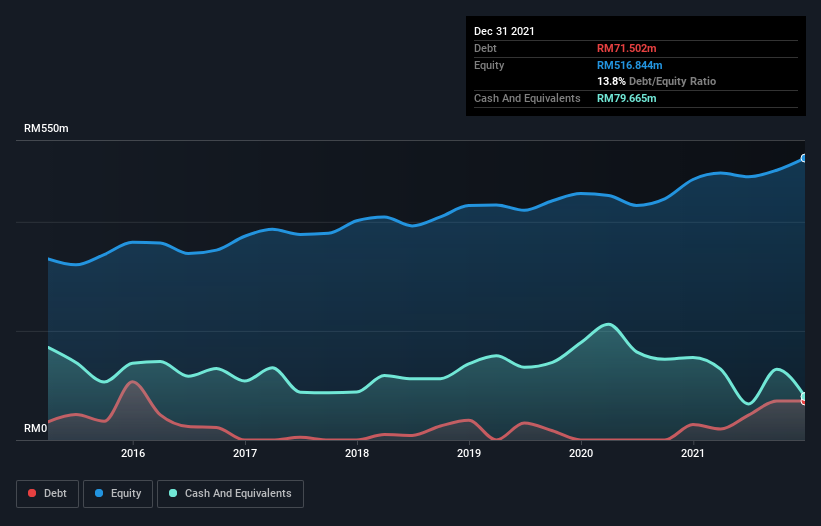- Malaysia
- /
- Electrical
- /
- KLSE:PIE
We Think P.I.E. Industrial Berhad (KLSE:PIE) Can Stay On Top Of Its Debt

Howard Marks put it nicely when he said that, rather than worrying about share price volatility, 'The possibility of permanent loss is the risk I worry about... and every practical investor I know worries about.' It's only natural to consider a company's balance sheet when you examine how risky it is, since debt is often involved when a business collapses. Importantly, P.I.E. Industrial Berhad (KLSE:PIE) does carry debt. But the real question is whether this debt is making the company risky.
What Risk Does Debt Bring?
Generally speaking, debt only becomes a real problem when a company can't easily pay it off, either by raising capital or with its own cash flow. Part and parcel of capitalism is the process of 'creative destruction' where failed businesses are mercilessly liquidated by their bankers. However, a more frequent (but still costly) occurrence is where a company must issue shares at bargain-basement prices, permanently diluting shareholders, just to shore up its balance sheet. Of course, debt can be an important tool in businesses, particularly capital heavy businesses. The first step when considering a company's debt levels is to consider its cash and debt together.
Check out our latest analysis for P.I.E. Industrial Berhad
What Is P.I.E. Industrial Berhad's Net Debt?
The image below, which you can click on for greater detail, shows that at December 2021 P.I.E. Industrial Berhad had debt of RM71.5m, up from RM28.3m in one year. But on the other hand it also has RM79.7m in cash, leading to a RM8.16m net cash position.

A Look At P.I.E. Industrial Berhad's Liabilities
The latest balance sheet data shows that P.I.E. Industrial Berhad had liabilities of RM302.5m due within a year, and liabilities of RM7.33m falling due after that. On the other hand, it had cash of RM79.7m and RM257.7m worth of receivables due within a year. So it actually has RM27.5m more liquid assets than total liabilities.
This short term liquidity is a sign that P.I.E. Industrial Berhad could probably pay off its debt with ease, as its balance sheet is far from stretched. Succinctly put, P.I.E. Industrial Berhad boasts net cash, so it's fair to say it does not have a heavy debt load!
Also positive, P.I.E. Industrial Berhad grew its EBIT by 26% in the last year, and that should make it easier to pay down debt, going forward. The balance sheet is clearly the area to focus on when you are analysing debt. But ultimately the future profitability of the business will decide if P.I.E. Industrial Berhad can strengthen its balance sheet over time. So if you want to see what the professionals think, you might find this free report on analyst profit forecasts to be interesting.
Finally, a company can only pay off debt with cold hard cash, not accounting profits. While P.I.E. Industrial Berhad has net cash on its balance sheet, it's still worth taking a look at its ability to convert earnings before interest and tax (EBIT) to free cash flow, to help us understand how quickly it is building (or eroding) that cash balance. Over the last three years, P.I.E. Industrial Berhad saw substantial negative free cash flow, in total. While investors are no doubt expecting a reversal of that situation in due course, it clearly does mean its use of debt is more risky.
Summing up
While we empathize with investors who find debt concerning, you should keep in mind that P.I.E. Industrial Berhad has net cash of RM8.16m, as well as more liquid assets than liabilities. And we liked the look of last year's 26% year-on-year EBIT growth. So we are not troubled with P.I.E. Industrial Berhad's debt use. The balance sheet is clearly the area to focus on when you are analysing debt. But ultimately, every company can contain risks that exist outside of the balance sheet. Be aware that P.I.E. Industrial Berhad is showing 2 warning signs in our investment analysis , and 1 of those is potentially serious...
Of course, if you're the type of investor who prefers buying stocks without the burden of debt, then don't hesitate to discover our exclusive list of net cash growth stocks, today.
New: Manage All Your Stock Portfolios in One Place
We've created the ultimate portfolio companion for stock investors, and it's free.
• Connect an unlimited number of Portfolios and see your total in one currency
• Be alerted to new Warning Signs or Risks via email or mobile
• Track the Fair Value of your stocks
Have feedback on this article? Concerned about the content? Get in touch with us directly. Alternatively, email editorial-team (at) simplywallst.com.
This article by Simply Wall St is general in nature. We provide commentary based on historical data and analyst forecasts only using an unbiased methodology and our articles are not intended to be financial advice. It does not constitute a recommendation to buy or sell any stock, and does not take account of your objectives, or your financial situation. We aim to bring you long-term focused analysis driven by fundamental data. Note that our analysis may not factor in the latest price-sensitive company announcements or qualitative material. Simply Wall St has no position in any stocks mentioned.
About KLSE:PIE
P.I.E. Industrial Berhad
An investment holding company, manufactures and sells industrial products in Malaysia, the United States, other Asia Pacific countries, Europe, and Africa.
High growth potential with excellent balance sheet.
Similar Companies
Market Insights
Community Narratives



